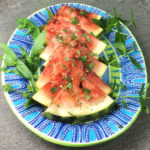 |
| Our smoked strawberries work perfectly to make a smoked strawberry marinade for our pork or any other meat! |
If you’re like me, you love strawberries for the incredible juice they contain. One of my favorite ways to capture the essence of that juice is to smoke the strawberries on a grill. Not only do you end up with phenomenal smoked strawberries but the juice the grilling/smoking process renders is a must-have ingredient for so many recipes. I took a batch of the smoked juices and made a fabulous marinade for fish, chicken, turkey, pork, lamb, and goat.
The Simple Grilling Method
 Whether you elect to use a standard gas grill or a charcoal grill, you’ll want to use wood chunks from SmokinLicious® to bring clean smoke flavors to the strawberries. You can visit our previous articles on smoking on a gas or charcoal grill in Dr. Smoke’s Tips and Technique.
Whether you elect to use a standard gas grill or a charcoal grill, you’ll want to use wood chunks from SmokinLicious® to bring clean smoke flavors to the strawberries. You can visit our previous articles on smoking on a gas or charcoal grill in Dr. Smoke’s Tips and Technique.For me, I’m using a gas grill equipped with single filet wood chunks. I prefer to use more mild hardwoods when smoking fruits like Ash, Alder, Cherry, and Maple.
The Smoked Strawberry Marinade Recipe
This marinade is so simple yet really packs great flavor. Of course, the longer you marinate your protein, the better the outcome. For one cup of marinade you’ll need:- 1 cup of smoked strawberry juice
- Juice of 2 limes
- 2 tablespoons blueberry balsamic vinegar or similar fruity flavor
- ¼ cup Cajun seasoning
- 1 tablespoon ground chipotle pepper

Now you can choose the cooking method to bring all the flavors together. Grill, oven roasting or even smoking. Once you’ve selected your cooking method, remove the marinated meat from the bag and cook until done. Remember, the marinade has been used on raw meat so you cannot reuse it as it will contain some bacteria.






